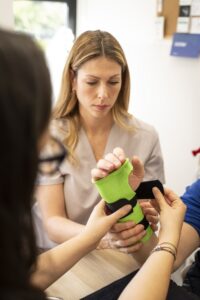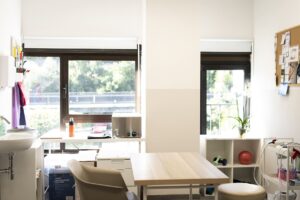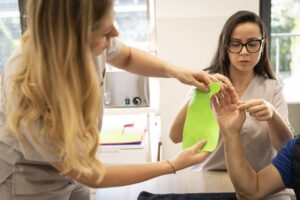By Chiara Petrella
“The hand is the true organ of civilization, the initiator of human evolution” said the German writer, philosopher and critic Ernst Fischer in the last century, exploring the relationship between art, work and society and identifying, precisely in the upper limbs, the main instrument for the development of civilization, reason and conscience. In Siena and Grosseto there are two centres of excellence where it is possible to take care of them in case of trauma or other pathologies.
 Their names are Giulia Pompili and Celeste Magara and their welcoming smile strikes us immediately when we go to meet them in Siena, at the Igea Medical Center, one of the two where the young women work. The other is Studio Beside in Grosseto. Their specialization is hand and upper limb physiotherapy, operating in conservative and post-surgical rehabilitation, as well as in degenerative, rheumatological, compressive and post-traumatic inflammatory pathologies. “The hand is a highly complex anatomical district and requires specialized care, both medically and physiotherapeutically,” they explain to us in technical and professional language, but not without that kindness that is an integral part of treatments when the ultimate goal is personal care. “Hand rehabilitation – they continue – uses rehabilitation tools and principles based on scientific evidence that are very often unusual for those who are used to seeing a traditional physiotherapy gym. We use many manipulative objects that help improve movement, sensitivity, muscle strengthening and proprioception, i.e. motor awareness in the space around us”.
Their names are Giulia Pompili and Celeste Magara and their welcoming smile strikes us immediately when we go to meet them in Siena, at the Igea Medical Center, one of the two where the young women work. The other is Studio Beside in Grosseto. Their specialization is hand and upper limb physiotherapy, operating in conservative and post-surgical rehabilitation, as well as in degenerative, rheumatological, compressive and post-traumatic inflammatory pathologies. “The hand is a highly complex anatomical district and requires specialized care, both medically and physiotherapeutically,” they explain to us in technical and professional language, but not without that kindness that is an integral part of treatments when the ultimate goal is personal care. “Hand rehabilitation – they continue – uses rehabilitation tools and principles based on scientific evidence that are very often unusual for those who are used to seeing a traditional physiotherapy gym. We use many manipulative objects that help improve movement, sensitivity, muscle strengthening and proprioception, i.e. motor awareness in the space around us”.
The two professionals deal with common pathologies that affect a large part of the population, such as nerve compressions (carpal tunnel and cubital tunnel that cause the annoying nocturnal “tingling”), osteoarthritis, rhizoarthrosis (osteoarthritis of the base of the thumb), tendinopathies (as a result of strenuous work as in the case of the “trigger finger”), sports activity (epicondylitis) and hormonal imbalances (as in the case of De Quervain’s Syndrome), but they also collaborate with orthopaedists specialized in the diagnosis and treatment of hand pathologies both conservatively and surgically.
“We always pay close attention to taking care of the patient, especially in post-surgical problems as we know the optimal timing to schedule the first physiotherapy consultation with a view to reducing the recovery period, ensuring the best post-operative course and the best possible functional result”.

Giulia and Celeste are in fact also part of the AIRM (Italian Association of Hand Rehabilitation) a scientific association that has brought together professionals in the field of rehabilitation, mainly physiotherapists and occupational therapists who deal with the care and functional recovery in this specific sector. The association cooperates closely with the Italian Society of Hand Surgery (SICM), which brings together surgeons specialized in hand, wrist and forearm operations, and the two bodies organize joint congresses and events to encourage exchange and collaboration between the two professional figures (surgeons and therapists), which is essential to set up a valid and effective treatment path. “Collaboration and direct communication between surgeon and hand therapist – they explain – is essential for the best complete functional recovery of the patient, both in the case of conservative and post-surgical treatment. This synergy ensures personalized treatments, optimizes the recovery path and helps prevent the onset of possible complications. Thanks to the collaboration between our scientific societies, active participation in events and congress activities of interest, we are in connection with hand surgery in our country. In this way, we are able to help and direct patients to the specialist surgical centre most useful for their specific problem”.

Valleylife: “Do the treatments consist only of specific gymnastics or do you also use machinery or other techniques?”
G and C: “We also make use of the packaging of functional braces that are to all intents and purposes part of the rehabilitation program. They are braces that we make to measure, usually with thermoplastic material, specific for this practice, and are useful for correctly and precisely immobilizing anatomical districts following fractures/dislocations but can also be used to avoid or support some movements. Braces can be an integral part of the rehabilitation protocol: for example, following tendon injuries they serve to promote a protected early mobilization of the operated tendon or to position the district in such a way as to promote healing in the correct position and prevent possible stiffness. They are also useful in case of joint stiffness or to protect against certain fractures, in this case the brace is prescribed by the doctor perhaps instead of a cast in order to avoid compression, itching or sweating, and they are much more comfortable on a daily basis as they can be wet and you can therefore shower or wash yourself”.
In short, Giulia and Celeste’s treatments are not only aimed at returning functionality to its highest possible level, but also at caring for the patient in terms of satisfaction in daily life, work and sports, where the hands play a fundamental role.

Info: Siena – Centro Medico Igea, Strada Massetana Romana, 12/6
Grossetto – Studio Beside, Via Aurelia Antica, 46/scala C
Dott.ssa Celeste Magara: +39 345 5759866 / celestemagara05@gmail.com
Dott.ssa Giulia Pompili: +39 339 5651731 / giulia.pompili90@gmail.com
